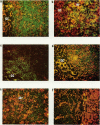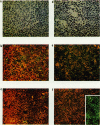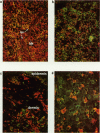Abstract
Tissue sections of frozen biopsy specimens obtained from normal and hyperplastic human lymphoid tissues, 33 cases of non-Hodgkin lymphomas as well as various forms of immunoregulatory disorders (angioimmunoblastic and dermatopathic lymphadenopathy) were analysed in immunofluorescence tests (using red TRITC and green FITC double-labelling). A panel of antisera including well-characterized conventional reagents to immunoglobulin classes, T lymphoid and Ia-like antigens, and monoclonal antibodies was used. In selected cases the results were compared with the observations of membrane-marker staining on viable cells in suspension. the findings show that the immunological methods can give a very accurate analysis of the normal and malignant lymphoid cells, and can provide complementary information to conventional histology. The investigator can choose the reagent combinations which give answers to various specific questions: e.g. antisera to light chains establish the monoclonality of lymphomas, whilst staining combinations for human T and Ia-like antigens are particularly useful in various immunoregulatory disorders. Monoclonal antibodies will be particularly useful in various immunoregulatory disorders. Monoclonal antibodies will be particularly useful reagents for analysing the tissue distribution of lymphoid subpopulations and ancillary cells in tissue biopsy specimens.
Full text
PDF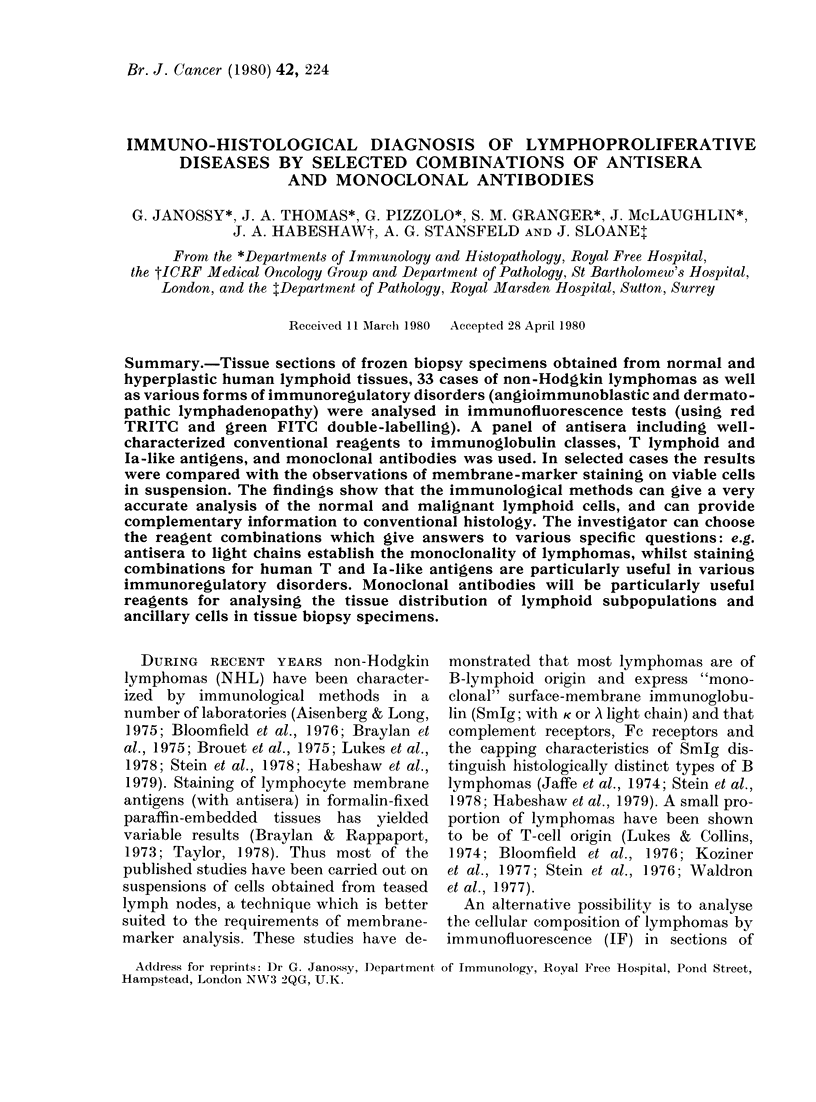
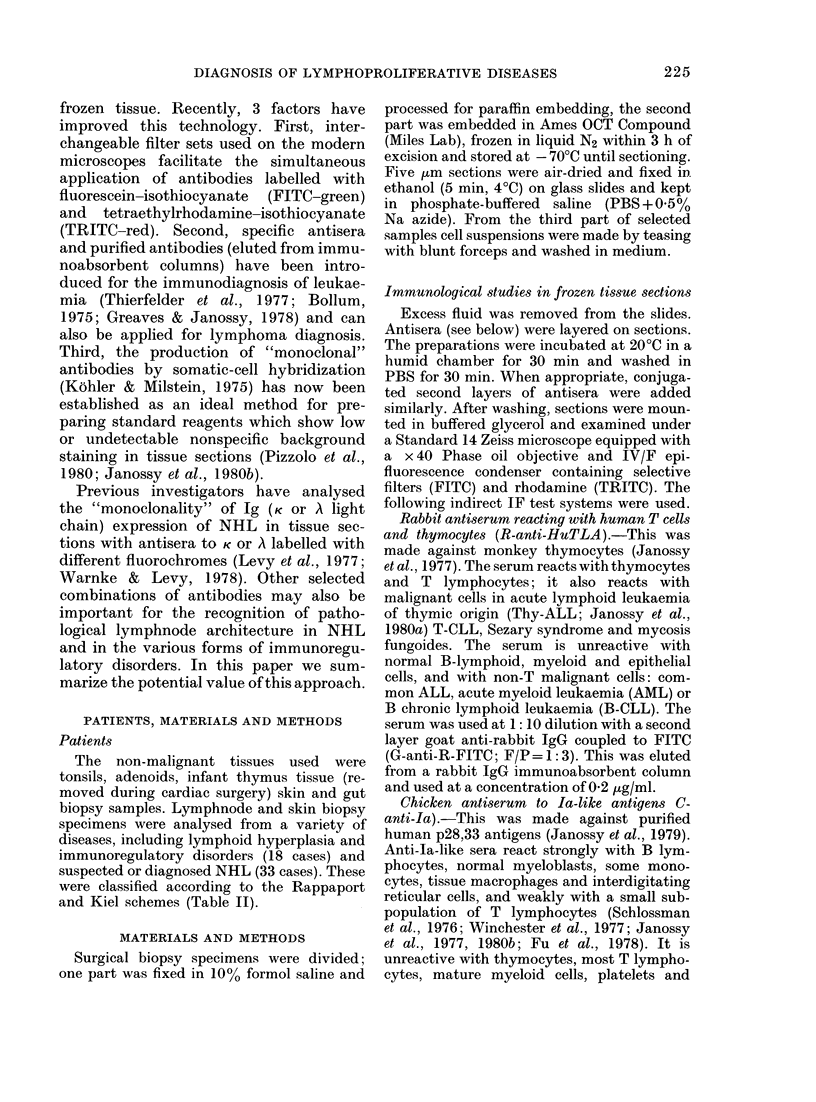
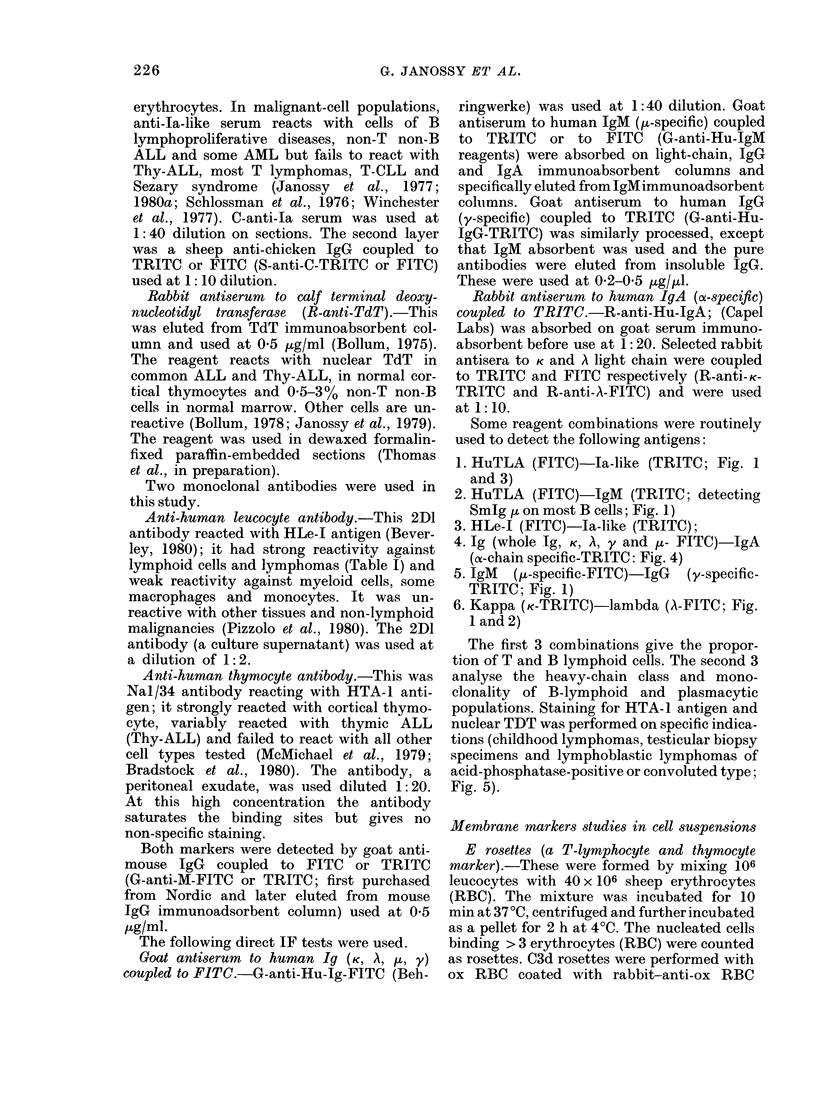
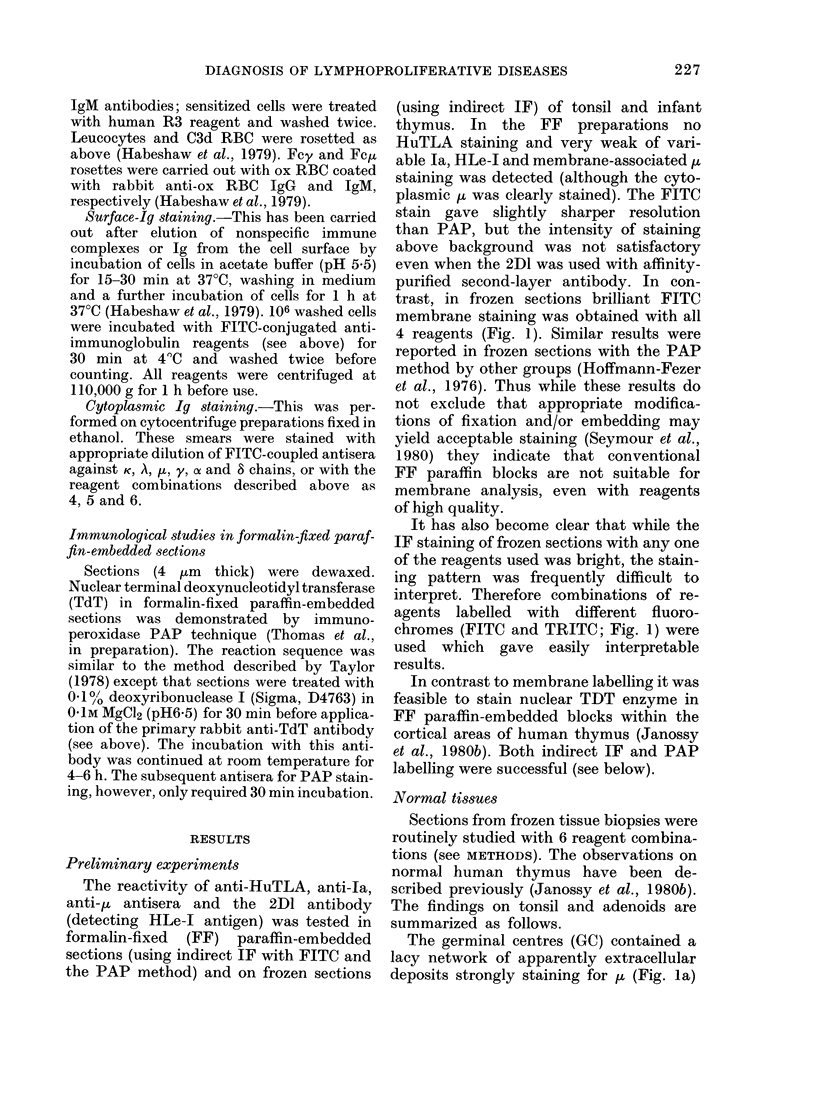

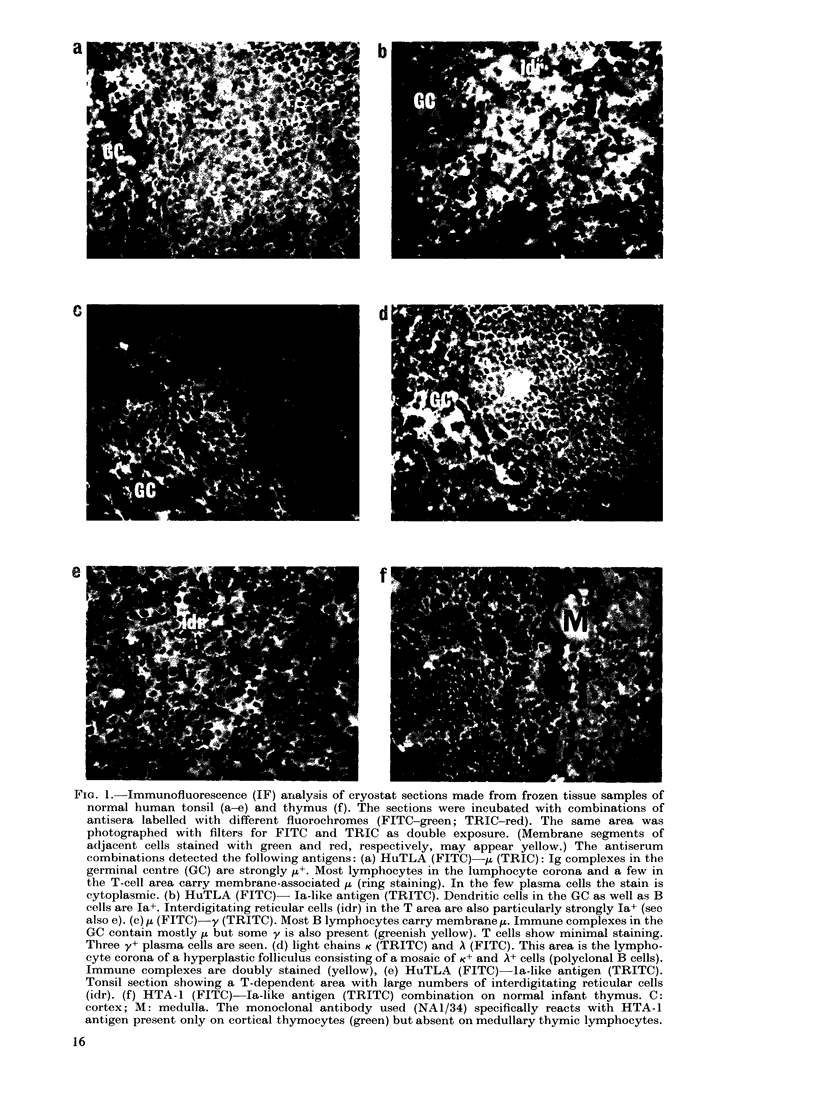
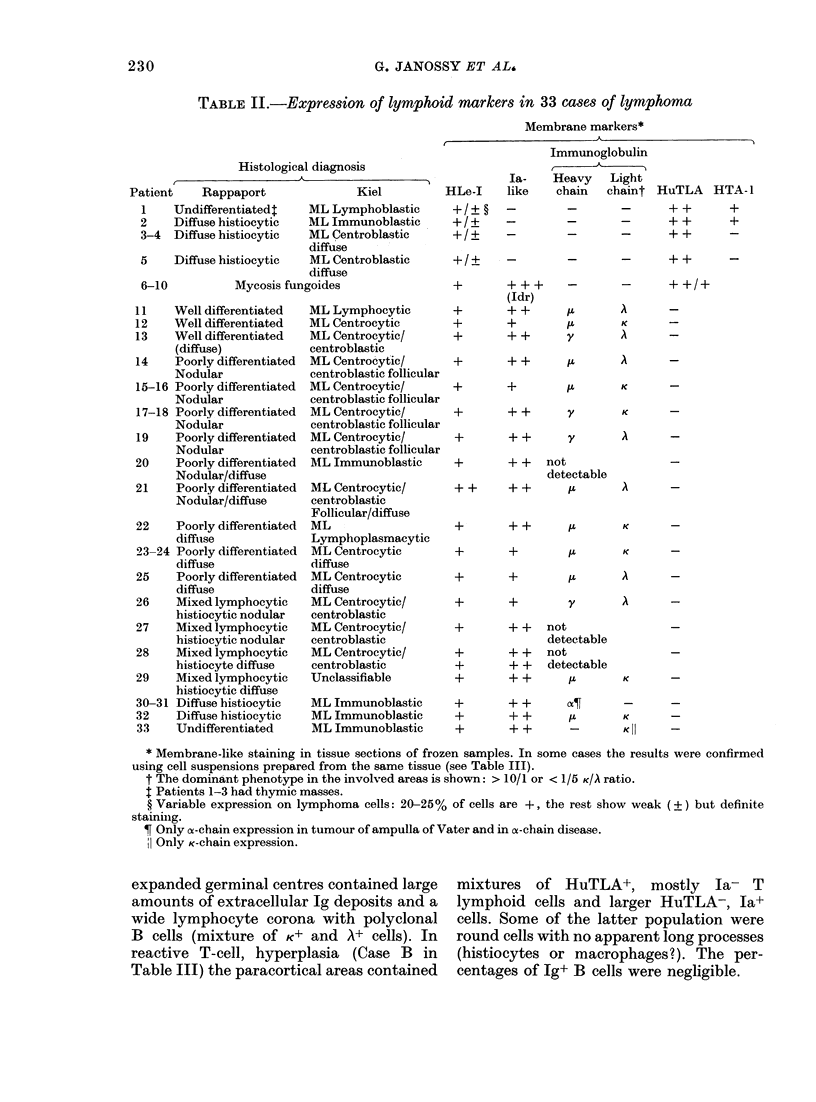
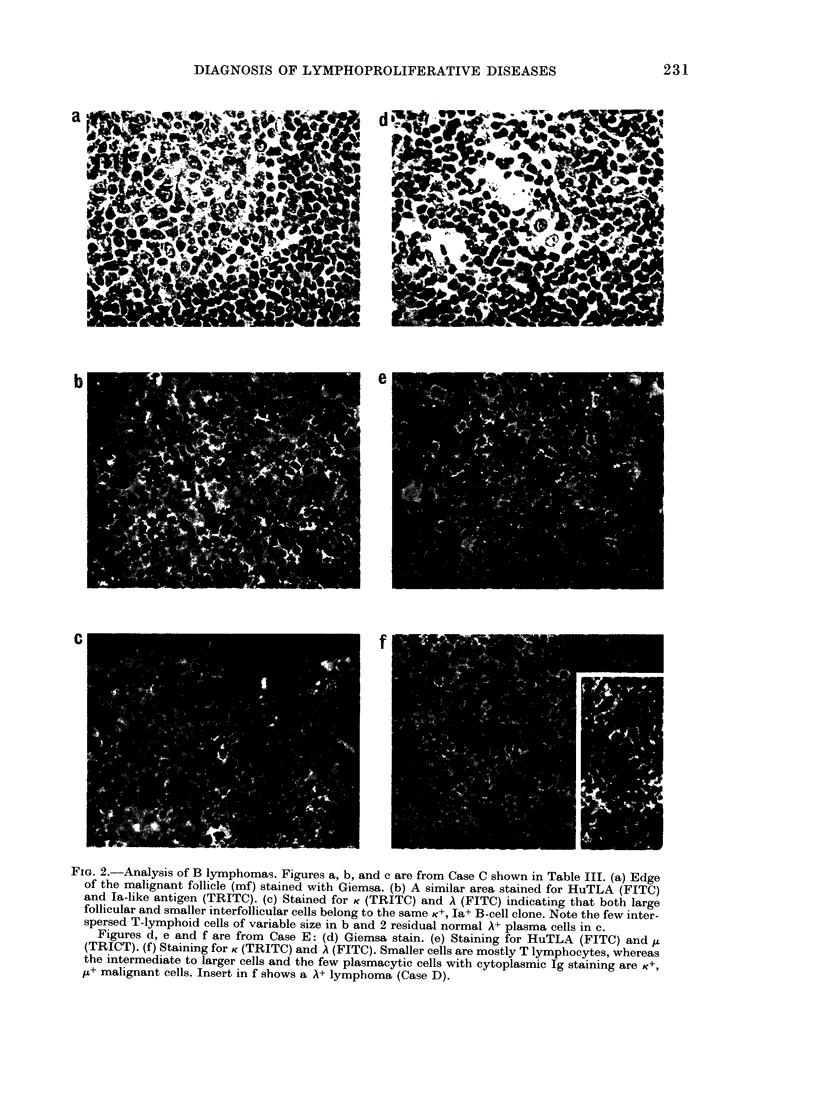
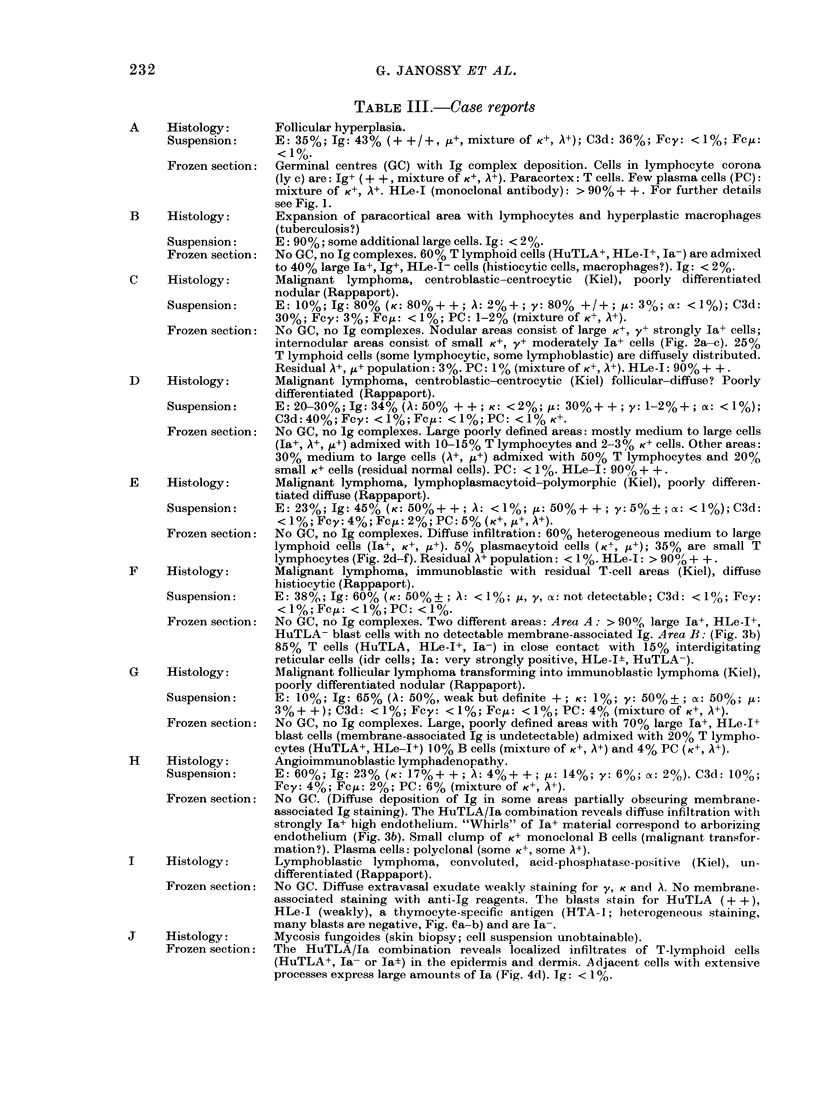
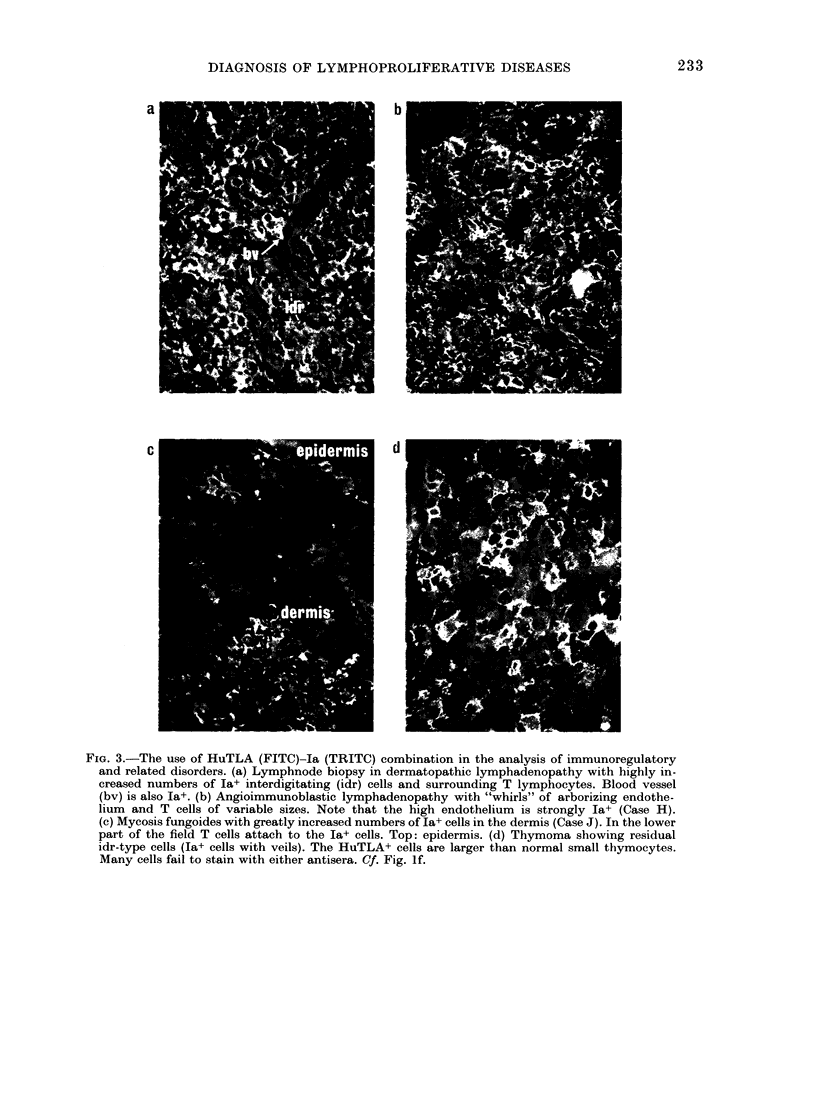
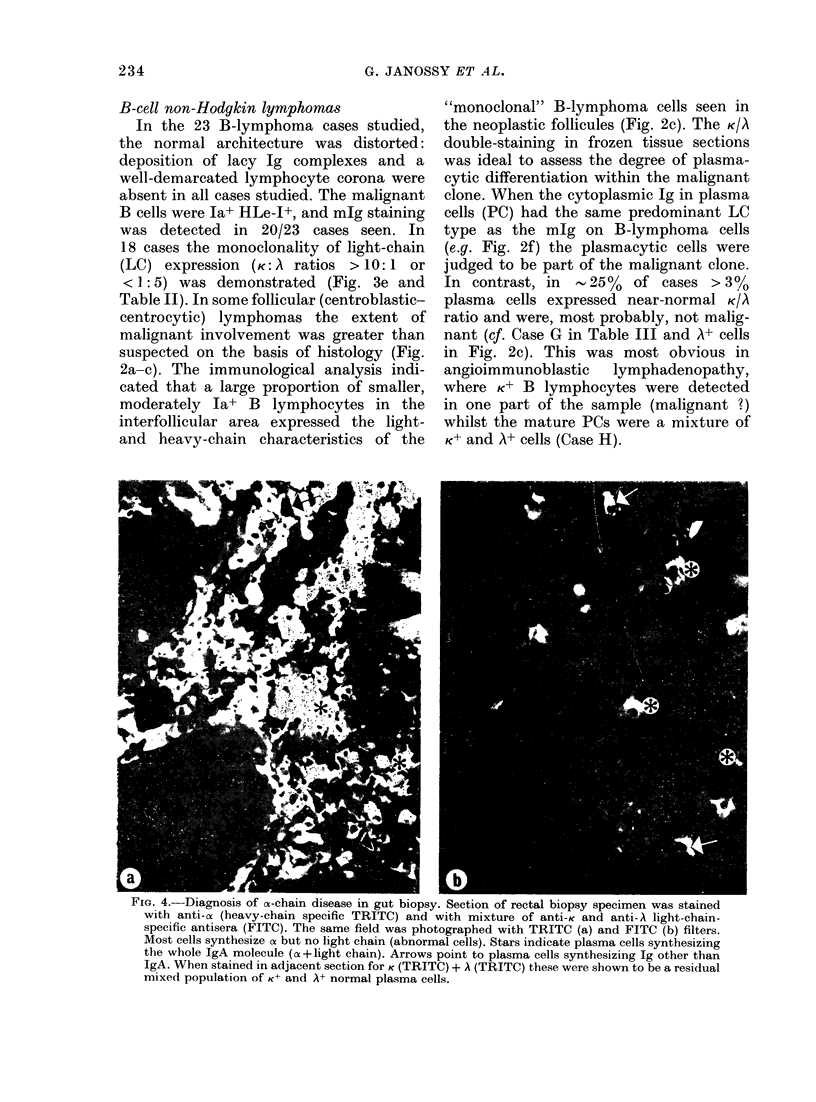

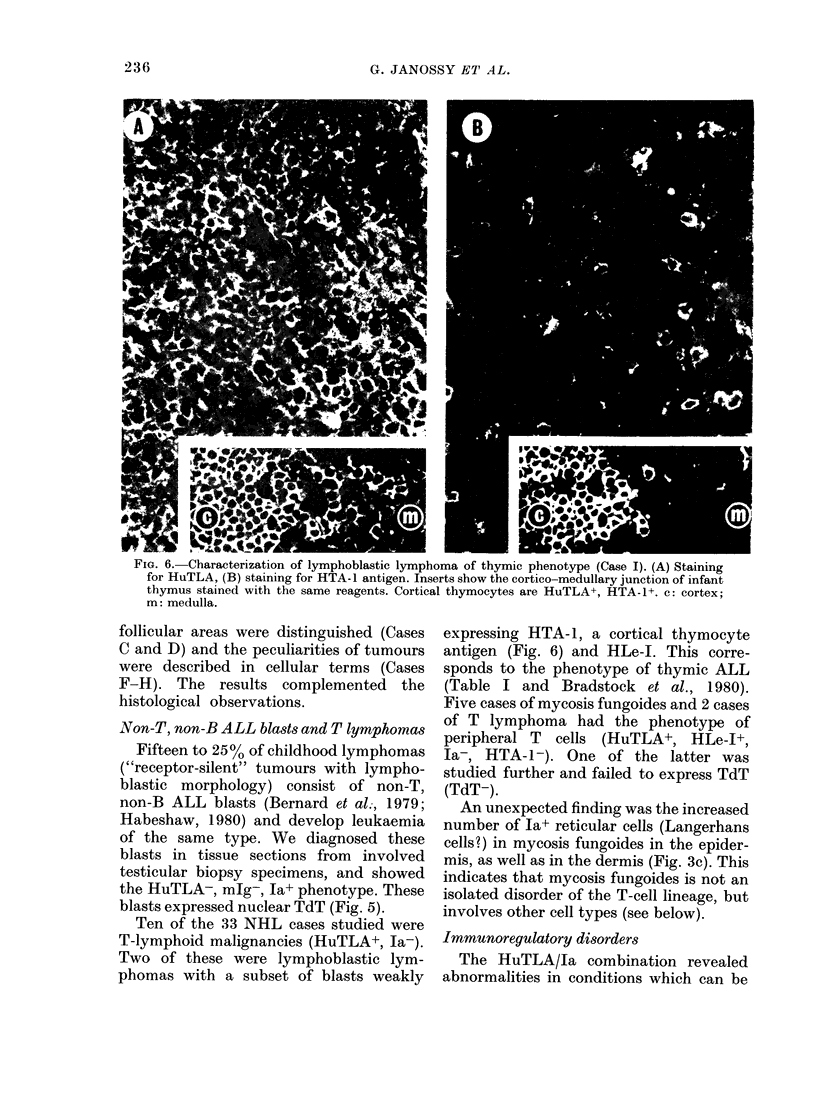
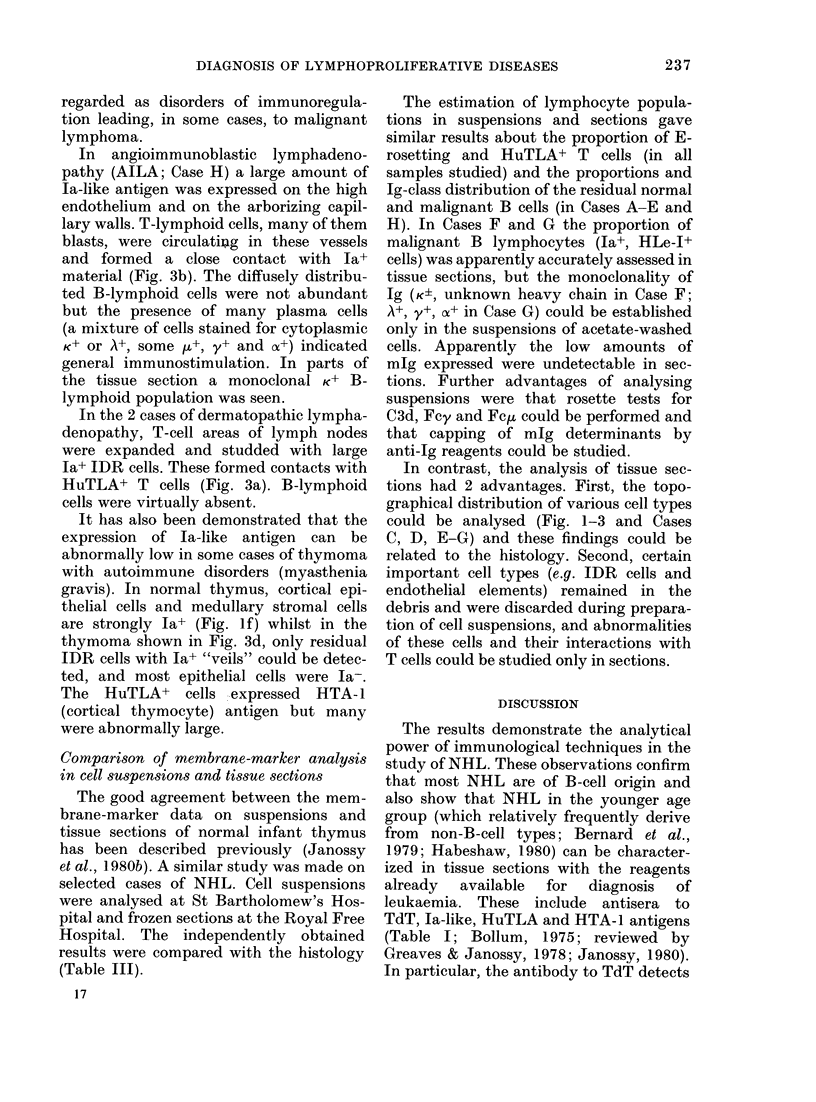
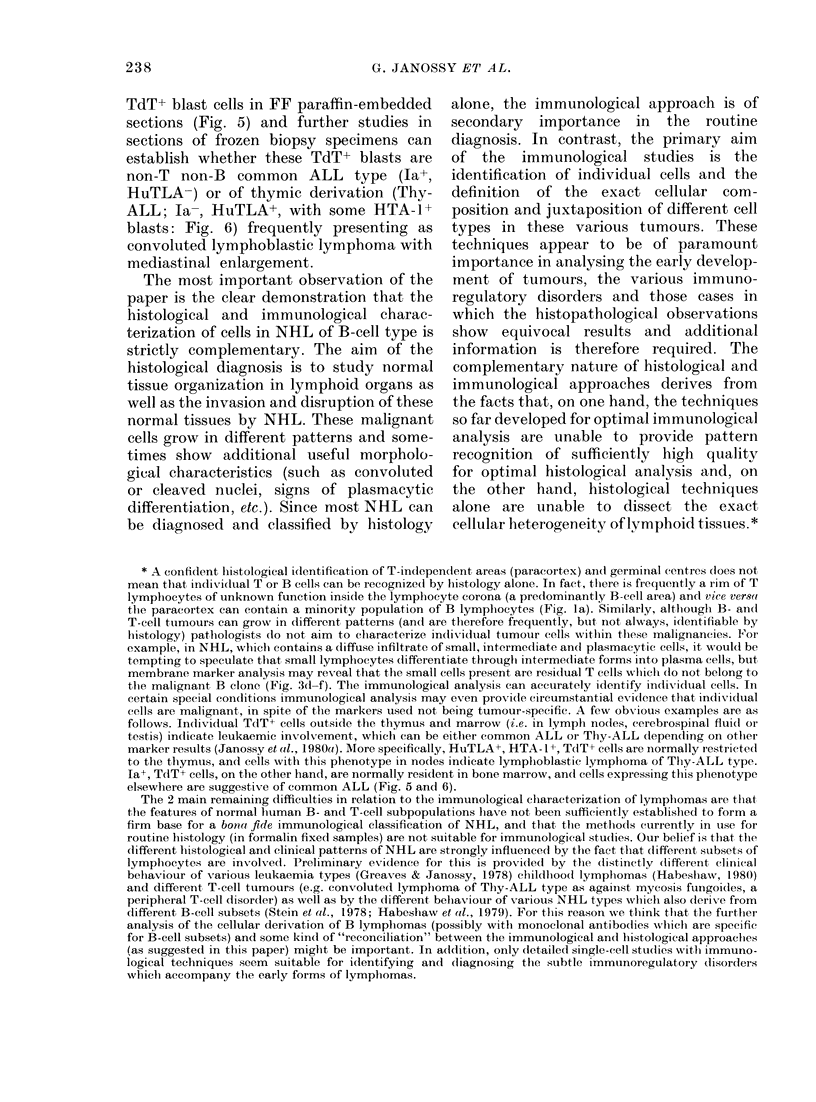
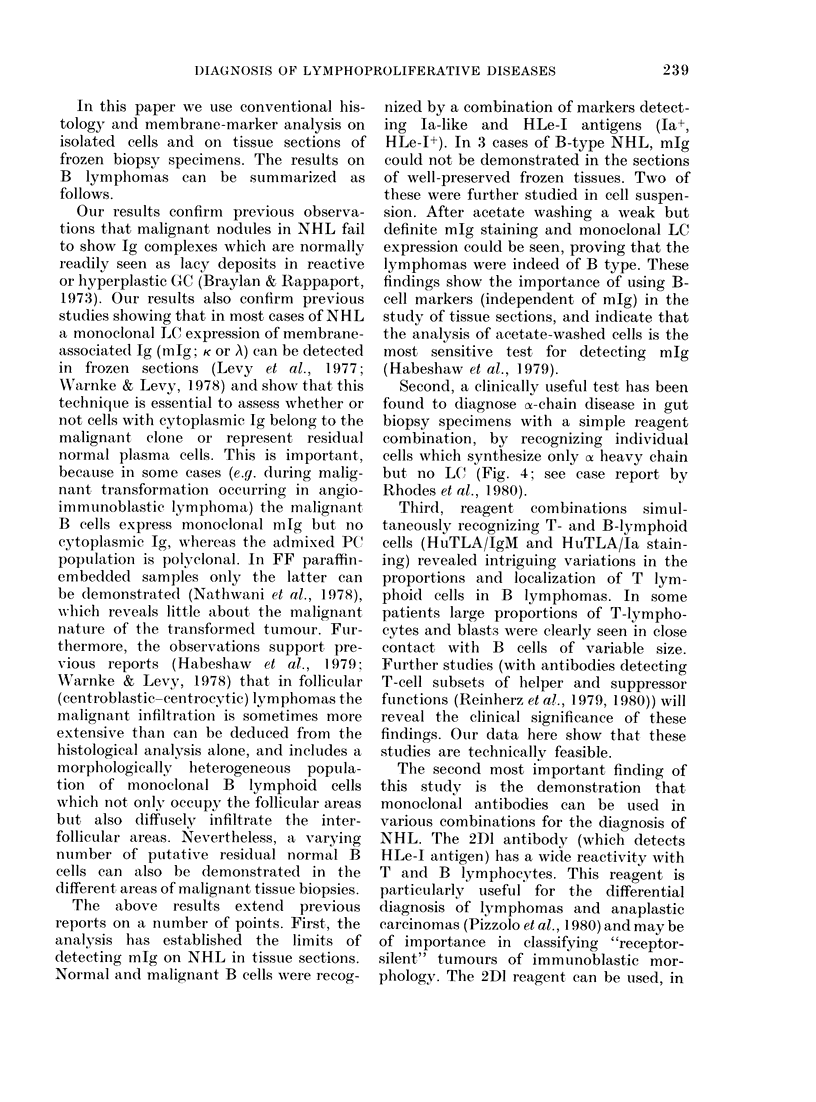
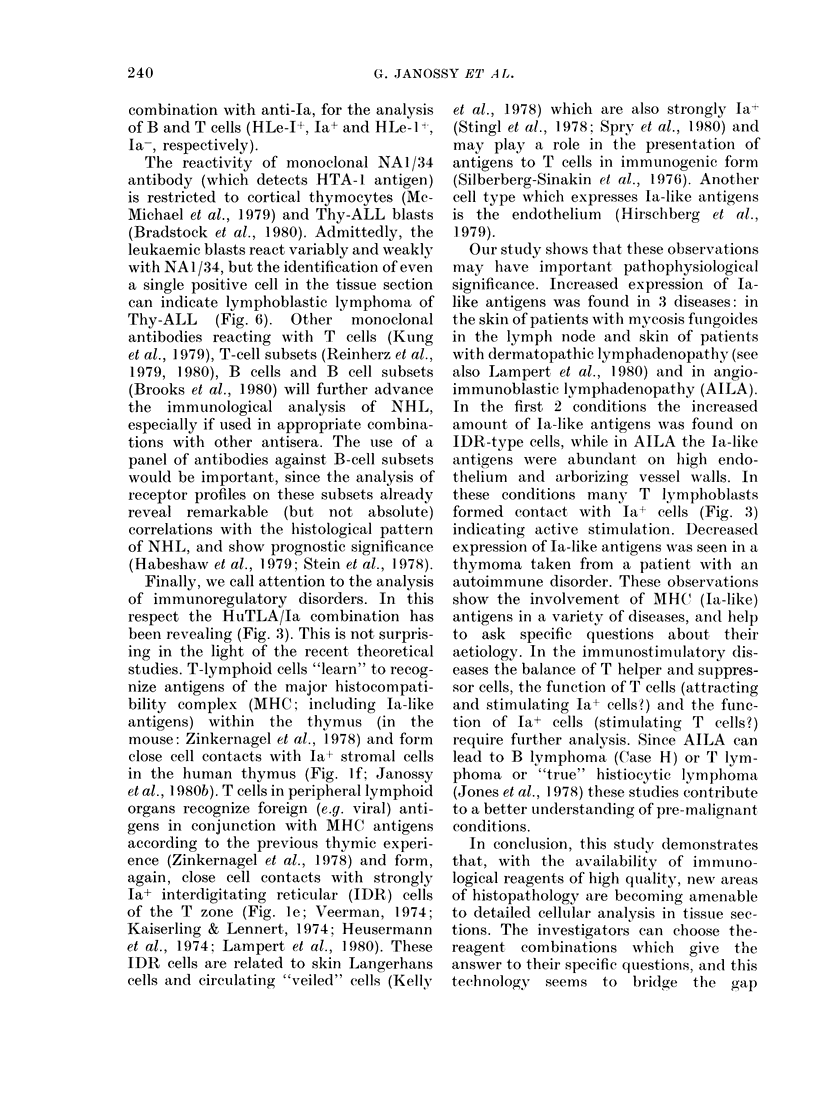
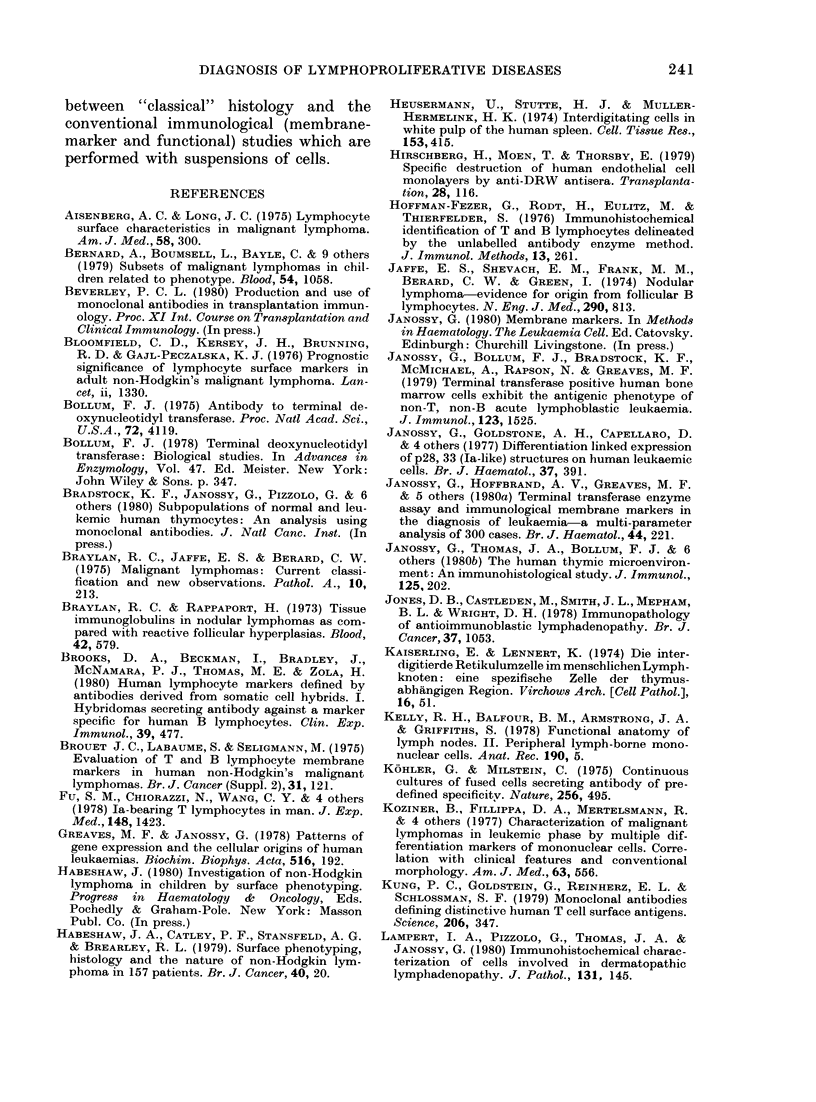
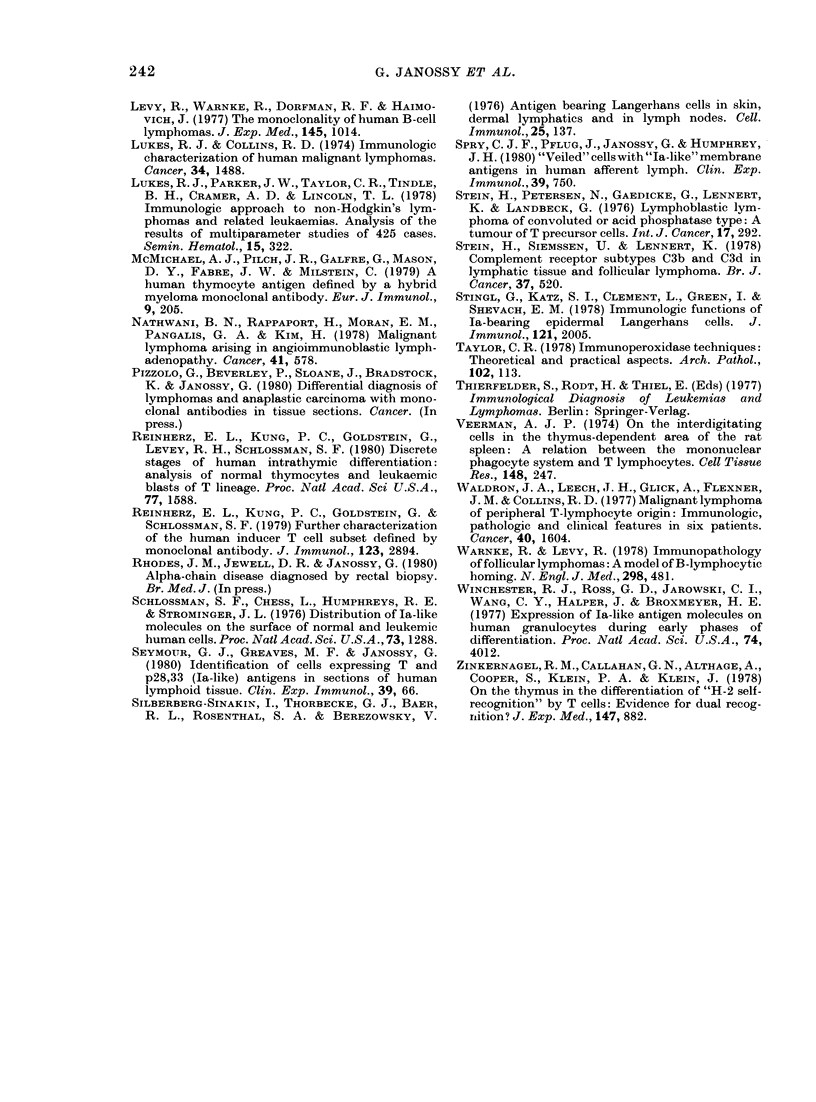
Images in this article
Selected References
These references are in PubMed. This may not be the complete list of references from this article.
- Aisenberg A. C., Long J. C. Lymphocyte surface characteristics in malignant lymphoma. Am J Med. 1975 Mar;58(3):300–306. doi: 10.1016/0002-9343(75)90595-1. [DOI] [PubMed] [Google Scholar]
- Bernard A., Boumsell L., Bayle C., Richard Y., Coppin H., Penit C., Rouget P., Micheau C., Clausse B., Gerard-Marchant R. Subsets of malignant lymphomas in children related to the cell phenotype. Blood. 1979 Nov;54(5):1058–1068. [PubMed] [Google Scholar]
- Bloomfield C. D., Kersey J. H., Brunning R. D., Gajl-Peczalska K. J. Prognostic significance of lymphocyte surface markers in adult non-Hodgkin's malignant lymphoma. Lancet. 1976 Dec 18;2(7999):1330–1333. doi: 10.1016/s0140-6736(76)91976-0. [DOI] [PubMed] [Google Scholar]
- Bollum F. J. Antibody to terminal deoxynucleotidyl transferase. Proc Natl Acad Sci U S A. 1975 Oct;72(10):4119–4122. doi: 10.1073/pnas.72.10.4119. [DOI] [PMC free article] [PubMed] [Google Scholar]
- Bollum F. J. Terminal deoxynucleotidyl transferase: biological studies. Adv Enzymol Relat Areas Mol Biol. 1978;47:347–374. doi: 10.1002/9780470122921.ch6. [DOI] [PubMed] [Google Scholar]
- Braylan R. C., Jaffe E. S., Berard C. W. Malignant lymphomas: current classification and new observations. Pathol Annu. 1975;10:213–270. [PubMed] [Google Scholar]
- Braylan R. C., Rappaport H. Tissue immunoglobulins in nodular lymphomas as compared with reactive follicular hyperplasias. Blood. 1973 Oct;42(4):579–589. [PubMed] [Google Scholar]
- Brooks D. A., Beckman I., Bradley J., McNamara P. J., Thomas M. E., Zola H. Human lymphocyte markers defined by antibodies derived from somatic cell hybrids. I. A hybridoma secreting antibody against a marker specific for human B lymphocytes. Clin Exp Immunol. 1980 Feb;39(2):477–485. [PMC free article] [PubMed] [Google Scholar]
- Brouet J. C., Labaume S., Seligmann M. Evaluation of T and B lymphocyte membrane markers in human non-Hodgkin malignant lymphomata. Br J Cancer Suppl. 1975 Mar;2:121–127. [PMC free article] [PubMed] [Google Scholar]
- Fu S. M., Chiorazzi N., Wang C. Y., Montrazeri G., Kunkel H. G., Ko H. S., Gottlieb A. B. Ia-bearing T lymphocytes in man. Their identification and role in the generation of allogeneic helper activity. J Exp Med. 1978 Nov 1;148(5):1423–1428. doi: 10.1084/jem.148.5.1423. [DOI] [PMC free article] [PubMed] [Google Scholar]
- Heusermann U., Stutte H. J., Müller-Hermelink H. K. Interdigitating cells in the white pulp of the human spleen. Cell Tissue Res. 1974;153(3):415–417. [PubMed] [Google Scholar]
- Hirschberg H., Moen T., Throsby E. Specific destruction of human endothelial cell monolayers by anti-DRw antisera. Transplantation. 1979 Aug;28(2):116–120. doi: 10.1097/00007890-197908000-00009. [DOI] [PubMed] [Google Scholar]
- Hoffmann-Fezer G., Rodt H., Eulitz M., Thierfelder S. Immunohistochemical identification of T- and B-lymphocytes delineated by the unlabeled antibody enzyme method. I. Anatomical distribution of theta-positive and Ig-positive cells in lymphoid organs of mice. J Immunol Methods. 1976;13(3-4):261–270. doi: 10.1016/0022-1759(76)90073-9. [DOI] [PubMed] [Google Scholar]
- Jaffe E. S., Shevach E. M., Frank M. M., Berard C. W., Green I. Nodular lymphoma--evidence for origin from follicular B lymphocytes. N Engl J Med. 1974 Apr 11;290(15):813–819. doi: 10.1056/NEJM197404112901501. [DOI] [PubMed] [Google Scholar]
- Janossy G., Bollum F. J., Bradstock K. F., McMichael A., Rapson N., Greaves M. F. Terminal transferase-positive human bone marrow cells exhibit the antigenic phenotype of common acute lymphoblastic leukemia. J Immunol. 1979 Oct;123(4):1525–1529. [PubMed] [Google Scholar]
- Janossy G., Goldstone A. H., Capellaro D., Greaves M. F., Kulenkampff J., Pippard M., Welsh K. Differentiation linked expression of p28,33 (Ia-like) structures on human leukaemic cells. Br J Haematol. 1977 Nov;37(3):391–402. doi: 10.1111/j.1365-2141.1977.tb01010.x. [DOI] [PubMed] [Google Scholar]
- Janossy G., Hoffbrand A. V., Greaves M. F., Ganeshaguru K., Pain C., Bradstock K. F., Prentice H. G., Kay H. E., Lister T. A. Terminal transferase enzyme assay and immunological membrane markers in the diagnosis of leukaemia: a multiparameter analysis of 300 cases. Br J Haematol. 1980 Feb;44(2):221–234. doi: 10.1111/j.1365-2141.1980.tb01204.x. [DOI] [PubMed] [Google Scholar]
- Janossy G., Thomas J. A., Bollum F. J., Granger S., Pizzolo G., Bradstock K. F., Wong L., McMichael A., Ganeshaguru K., Hoffbrand A. V. The human thymic microenvironment: an immunohistologic study. J Immunol. 1980 Jul;125(1):202–212. [PubMed] [Google Scholar]
- Jones D. B., Castleden M., Smith J. L., Mepham B. L., Wright D. H. Immunopathology of angioimmunoblastic lymphadenopathy. Br J Cancer. 1978 Jun;37(6):1053–1062. doi: 10.1038/bjc.1978.153. [DOI] [PMC free article] [PubMed] [Google Scholar]
- Kelly R. H., Balfour B. M., Armstrong J. A., Griffiths S. Functional anatomy of lymph nodes. II. Peripheral lymph-borne mononuclear cells. Anat Rec. 1978 Jan;190(1):5–21. doi: 10.1002/ar.1091900103. [DOI] [PubMed] [Google Scholar]
- Koziner B., Filippa D. A., Mertelsmann R., Gupta S., Clarkson B., Good R. A., Siegal F. P. Characterization of malignant lymphomas in leukemic phase by multiple differentiation markers of mononuclear cells. Correlations with clinical features and conventional morphology. Am J Med. 1977 Oct;63(4):556–567. doi: 10.1016/0002-9343(77)90201-7. [DOI] [PubMed] [Google Scholar]
- Kung P., Goldstein G., Reinherz E. L., Schlossman S. F. Monoclonal antibodies defining distinctive human T cell surface antigens. Science. 1979 Oct 19;206(4416):347–349. doi: 10.1126/science.314668. [DOI] [PubMed] [Google Scholar]
- Köhler G., Milstein C. Continuous cultures of fused cells secreting antibody of predefined specificity. Nature. 1975 Aug 7;256(5517):495–497. doi: 10.1038/256495a0. [DOI] [PubMed] [Google Scholar]
- Lampert I. A., Pizzolo G., Thomas A., Janossy G. Immuno-histochemical characterisation of cells involved in dermatopathic lymphadenopathy. J Pathol. 1980 Jun;131(2):145–156. doi: 10.1002/path.1711310207. [DOI] [PubMed] [Google Scholar]
- Levy R., Warnke R., Dorfman R. F., Haimovich J. The monoclonality of human B-cell lymphomas. J Exp Med. 1977 Apr 1;145(4):1014–1028. doi: 10.1084/jem.145.4.1014. [DOI] [PMC free article] [PubMed] [Google Scholar]
- Lukes R. J., Collins R. D. Immunologic characterization of human malignant lymphomas. Cancer. 1974 Oct;34(4 Suppl):suppl–suppl:1503. doi: 10.1002/1097-0142(197410)34:8+<1488::aid-cncr2820340822>3.0.co;2-c. [DOI] [PubMed] [Google Scholar]
- Lukes R. J., Parker J. W., Taylor C. R., Tindle B. H., Cramer A. D., Lincoln T. L. Immunologic approach to non-Hodgkin lymphomas and related leukemias. Analysis of the results of multiparameter studies of 425 cases. Semin Hematol. 1978 Oct;15(4):322–351. [PubMed] [Google Scholar]
- McMichael A. J., Pilch J. R., Galfré G., Mason D. Y., Fabre J. W., Milstein C. A human thymocyte antigen defined by a hybrid myeloma monoclonal antibody. Eur J Immunol. 1979 Mar;9(3):205–210. doi: 10.1002/eji.1830090307. [DOI] [PubMed] [Google Scholar]
- Nathwani B. N., Rappaport H., Moran E. M., Pangalis G. A., Kim H. Malignant lymphoma arising in angioimmunoblastic lymphadenopathy. Cancer. 1978 Feb;41(2):578–606. doi: 10.1002/1097-0142(197802)41:2<578::aid-cncr2820410226>3.0.co;2-8. [DOI] [PubMed] [Google Scholar]
- Reinherz E. L., Kung P. C., Goldstein G., Levey R. H., Schlossman S. F. Discrete stages of human intrathymic differentiation: analysis of normal thymocytes and leukemic lymphoblasts of T-cell lineage. Proc Natl Acad Sci U S A. 1980 Mar;77(3):1588–1592. doi: 10.1073/pnas.77.3.1588. [DOI] [PMC free article] [PubMed] [Google Scholar]
- Reinherz E. L., Kung P. C., Goldstein G., Schlossman S. F. Further characterization of the human inducer T cell subset defined by monoclonal antibody. J Immunol. 1979 Dec;123(6):2894–2896. [PubMed] [Google Scholar]
- Schlossman S. F., Chess L., Humphreys R. E., Strominger J. L. Distribution of Ia-like molecules on the surface of normal and leukemic human cells. Proc Natl Acad Sci U S A. 1976 Apr;73(4):1288–1292. doi: 10.1073/pnas.73.4.1288. [DOI] [PMC free article] [PubMed] [Google Scholar]
- Seymour G. J., Greaves M. F., Janossy G. Identification of cells expressing T and p28,33 (Ia-like) antigens in sections of human lymphoid tissue. Clin Exp Immunol. 1980 Jan;39(1):66–75. [PMC free article] [PubMed] [Google Scholar]
- Silberberg-Sinakin I., Thorbecke G. J., Baer R. L., Rosenthal S. A., Berezowsky V. Antigen-bearing langerhans cells in skin, dermal lymphatics and in lymph nodes. Cell Immunol. 1976 Aug;25(2):137–151. doi: 10.1016/0008-8749(76)90105-2. [DOI] [PubMed] [Google Scholar]
- Spry C. J., Pflug A. J., Janossy G., Humphrey J. H. Large mononuclear (veiled) cells like 'Ia-like' membrane antigens in human afferent lympn. Clin Exp Immunol. 1980 Mar;39(3):750–755. [PMC free article] [PubMed] [Google Scholar]
- Stein H., Petersen N., Gaedicke G., Lennert K., Landbeck G. Lymphoblastic lymphoma of convoluted or acid phosphatase type-a tumor of T precursor cells. Int J Cancer. 1976 Mar 15;17(3):292–295. doi: 10.1002/ijc.2910170303. [DOI] [PubMed] [Google Scholar]
- Stein H., Siemssen U., Lennert K. Complement receptor subtypes C3b and C3d in lymphatic tissue and follicular lymphoma. Br J Cancer. 1978 Apr;37(4):520–529. doi: 10.1038/bjc.1978.80. [DOI] [PMC free article] [PubMed] [Google Scholar]
- Stingl G., Katz S. I., Clement L., Green I., Shevach E. M. Immunologic functions of Ia-bearing epidermal Langerhans cells. J Immunol. 1978 Nov;121(5):2005–2013. [PubMed] [Google Scholar]
- Taylor C. R. Immunoperoxidase techniques: practical and theoretical aspects. Arch Pathol Lab Med. 1978 Mar;102(3):113–121. [PubMed] [Google Scholar]
- Veerman A. J. On the interdigitating cells in the thymus-dependent area of the rat spleen: a relation between the mononuclear phagocyte system and T-lymphocytes. Cell Tissue Res. 1974 Apr 11;148(2):247–257. doi: 10.1007/BF00224586. [DOI] [PubMed] [Google Scholar]
- Waldron J. A., Leech J. H., Glick A. D., Flexner J. M., Collins R. D. Malignant lymphoma of peripheral T-lymphocyte origin: immunologic, pathologic, and clinical features in six patients. Cancer. 1977 Oct;40(4):1604–1617. doi: 10.1002/1097-0142(197710)40:4<1604::aid-cncr2820400433>3.0.co;2-h. [DOI] [PubMed] [Google Scholar]
- Warnke R., Levy R. Immunopathology of follicular lymphomas. A model of B-lymphocyte homing. N Engl J Med. 1978 Mar 2;298(9):481–486. doi: 10.1056/NEJM197803022980903. [DOI] [PubMed] [Google Scholar]
- Winchester R. J., Ross G. D., Jarowski C. I., Wang C. Y., Halper J., Broxmeyer H. E. Expression of Ia-like antigen molecules on human granulocytes during early phases of differentiation. Proc Natl Acad Sci U S A. 1977 Sep;74(9):4012–4016. doi: 10.1073/pnas.74.9.4012. [DOI] [PMC free article] [PubMed] [Google Scholar]
- Zinkernagel R. M., Callahan G. N., Althage A., Cooper S., Klein P. A., Klein J. On the thymus in the differentiation of "H-2 self-recognition" by T cells: evidence for dual recognition? J Exp Med. 1978 Mar 1;147(3):882–896. doi: 10.1084/jem.147.3.882. [DOI] [PMC free article] [PubMed] [Google Scholar]



